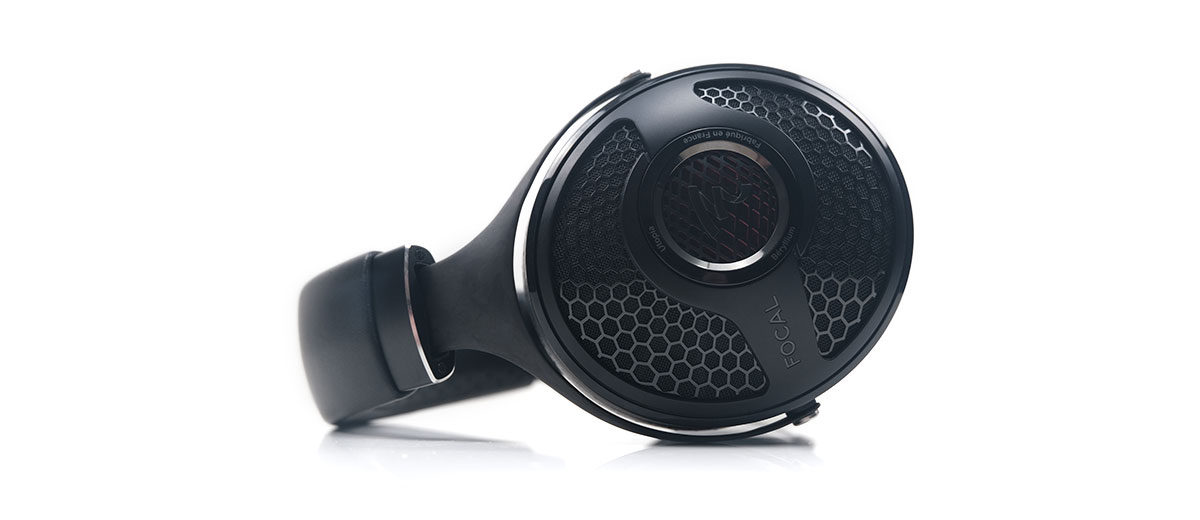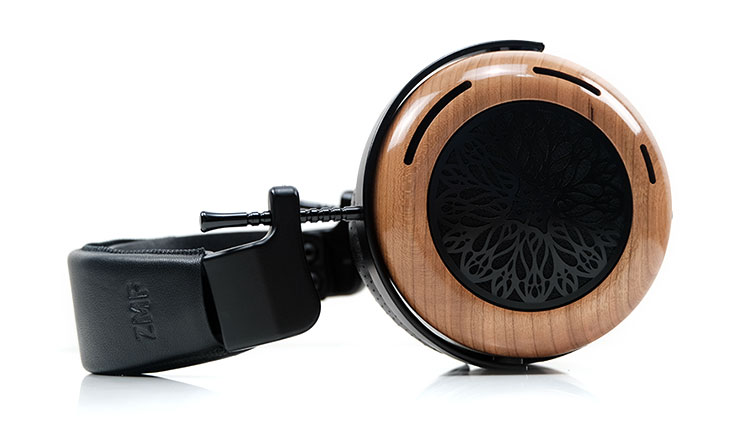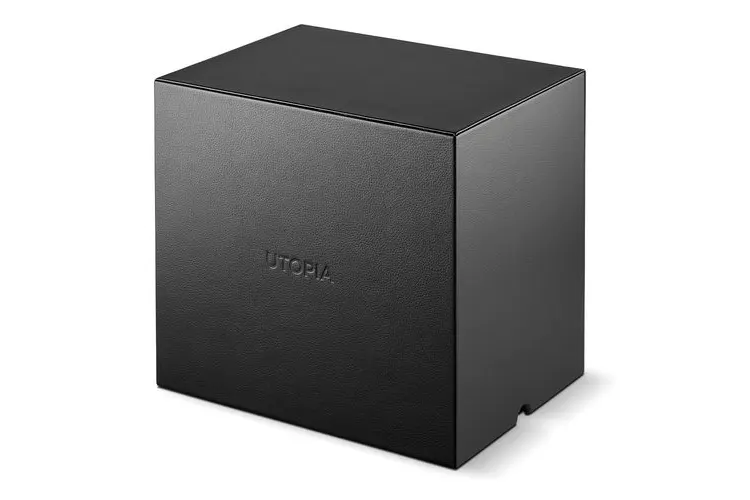Select Comparisons
The following comparisons to the Utopia 2022 were completed using a mix of the Ferrum OOR, Cayin’s HA-300MK2 for amplification, and a Holo Audio Spring II with an iBasso DX320 MAX Ti, (DAC-line out & amplifier), for decoding.
Dan Clark Audio EXPANSE
The Dan Clark Audio EXPANSE is the open-back sibling to the previously launched closed-back STEALTH and represents the next generation of headphone development from the San Diego-based company. It also won our Top Gear Editor’s Pick Award for 2022. You can find our full review of the EXPANSE here.
Technical
Driver implementation on a high level here is dynamic versus planar with the Utopia 2022 using Focal’s long-established low mass 40mm beryllium driver with an M-Dome diaphragm design combined with a new copper and aluminum alloy voice coil to improve reliability and keep it lightweight.
The EXPANSE is an open-back planar magnetic headphone and one which uses a new 76mm 4th gen driver first seen inside the Stealth last year. This is a single-sided V-planar driver and one that is almost 20% larger than the previous version inside the Ether 2 and the Ether C Flow. It also has the thinnest diaphragm DCA has created to date for its drivers.
It uses 11 magnets per channel positioned to the outside of the driver with an innovative AMTS or Acoustical Metamaterial Tuning System which sits inside the cups one per side for waveguide manipulation and diffusion control.
It also doubles up as both a programmable Helmholtz or quarter-wave resonator to control high-frequency standing waves and resonance via the ‘ramped’ shaped design.
The EXPANSE is rated at a nominal 23Ω impedance and though the SPL is not listed it’s not that far away from the Stealth which was rated at 86-87dB SPL. It does require decent current and voltage and normally works best with more powerful amplifiers rather than DAPs.
The Utopia 2022 has a much higher impedance of 80Ω though SPL is friendlier at 104 dB SPL / 1mW @ 1kHz. It is more forgiving of DAPs with good headroom but decent voltage from a desktop amplifier will bring it up to optimal levels.
Design
Both of these headphones are beautifully built with very distinct design languages that have progressively evolved down through the years.
The Utopia 2022 will seem the bigger of the two headphones but actually, the cups are somewhat smaller with the volumetric size having more to do with the rigid frame philosophy and the additional weight of the chosen materials at 490g compared to the EXPANSE’s official 418g rating.
One big advantage the EXPANSE does have is its articulating hinge which allows it to fold up into a much smaller and more portable form factor. It will seem the more flexible of the two as a result with a much smaller case for portability.
The material choices on both are excellent with the EXPANSE using high-class USA vat-dyed leather, vegan suede, and titanium nickel, (Nitinol), for the headband structure.
The Utopia 2022 uses a slightly heavier mix of forged recycled carbon fiber, leather for the pads and headband, and what I presume to be an aluminum alloy for the striking honeycomb design.
The EXPANSE has its own striking teardrop-shaped cup design also with a concave grill formed from intricate generative design patterns based on mathematical formulae.
With soft leather finishing on both the pad and headband, both of these headphones are more than comfortable. However, I would give an edge to the EXPANSE since it is lighter with longer ovoid pad openings that clear your ear a bit more.
The EXPANSE pressure strap also dissipates pressure a bit more compared to the narrower Utopia 2022 design so less potential for scalp hotspots with prolonged listening.
Performance
The EXPANSE is what I would define as natural to neutral in overall timbral coloration and you will hear that lilt more to a tonally correct tuning compared to the Utopia 2022 which is a little warmer and richer in parts when A/B’ed.
Some of the key FR differences will account for that. The EXPANSE is on a rising curve sub-100Hz with a stronger sub-bass presence compared to the more neutral 50 to 60Hz response from the Utopia 2020.
However, the EXPANSE mid-bass presence is reduced at a more rapid pace compared to the Utopia 2022’s elevated and elongated mid-to-upper bass to around 400Hz so slightly less warmth.
The Utopia 2022 is just above the Harman Target curve almost to 2k bringing with it a stronger voluptuous mid-bass punch to its sound signature combined with a lower-mids range that is more to the fore and warmer sounding.
The EXPANSE keeps it flatter through the same region but pulls up a better sub-bass fundamental when called upon. In a nutshell, it’s punch and richness from Utopia 2022, with depth and sub-bass power from the EXPANSE.
Mids and vocal presence are a little further forward also on the EXPANSE with a stronger 2-5k range and a little treble overtone from a 6-7k that appears more on solid-state neutral amplifiers. The Utopia 2022 also has some treble push around 7k but is just barely above the Target curve so it is subtle rather than overt.
You will find the staging dimensions of Utopia 2022 more on the intimate side. Acoustical reverb and percussion energy is more apparent on the EXPANSE giving you a stronger sense of space and height. The Utopia 2022 pulls it in a little but the control and clarity are still excellent.
Final D8000 Pro
The Final D8000 Pro is a refined version of the original flagship D8000 and was launched back in late 2019 with our thoughts in 2021. You can find our full review of the D8000 Pro here.
Technical
Like the EXPANSE, this is another dynamic driver versus planar driver comparison. The Utopia 2022 uses a low mass 40mm beryllium driver with an M-Dome diaphragm design combined with a new copper and aluminum alloy voice coil to improve reliability and keep it lightweight.
The D8000 Pro uses a slightly larger planar magnetic 50mm driver with a dual magnet array and a diaphragm pulled from the original D8000 headphone. The key to its implementation is Final’s ADFS technology which was first seen on the D8000 and is now refined on the D8000 Pro.
AFDS stands for Air Film Damping System, with air film between the magnets acting like an air buffer and cushioning the diaphragm in such a way as to reduce the level of contact with the magnets. With less contact, it should mean less distortion at the lowest level and a more coherent bass response compared to regular designs.
The D8000 Pro is a fairly efficient planar at 98dB @1Khz SPL and 60Ω impedance though like most headphones of this nature it will welcome quality power from a good desktop amplifier in much the same manner as the dynamic driver inside the Utopia 2022 with its 80Ω and 104 dB SPL / 1mW @ 1kHz rating.
Design
Both are full-size circumaural designs but where the Utopia excels in comfort despite its visually larger size, the more dimensionally compact D8000 Pro has some challenges.
At 523gm the D8000 Pro is not that much heavier than the Utopia 2022 but it’s the pressure displacement combined with its earpad design and the length of the headband that makes it less comfortable on the head.
There is a lot of downward or vertical pressure with a looser lateral clamp on the D8000 Pro that can push down on the top of your ear. The foam itself has some movement in it that doesn’t quite form and grip to cups like the Utopia 2022 pads so the actual frame of the headphones can move relative to the pad position.
The Utopia 2022 pressure balance feels more natural on my head and though it clamps a little more on the underside of the cup to the neck it doesn’t move around as much.
Aesthetically, the D8000 Pro is striking but perhaps a shade simpler in its up aluminum magnesium alloy construction with less open venting and complex grills designs compared to the Utopia 2022.
A slightly spartan mixed with that silvery Yamaha orthodynamic retro-design gives the D8000 Pro a distinct look compared to the lower profile but the more complex executive vibe from the Utopia 2022.
One last note is on the cables. The D8000 Pro comes with single-ended only terminations compared to the balanced XLR option with the Utopia 2022. However, the longer 3m OFC silver-coated cable of the Final headphones is both striking and beautifully made. Just a pity it did not come balanced terminated.
Performance
Of the two, the Utopia 2022 is the more relaxed and warmer-sounding headphone. Both excel in resolution and the overall clarity is excellent but your ear is drawn to different aspects of each headphones performance courtesy of some significant FR differences.
The Utopia 2022 is all about the mid-bass punch, the lower-mid warmth, and a smoother richer vocal delivery. With the D8000 Pro, it is a clean and more neutral tone, slightly drier in the upper mids but with more treble sparkle. The former will bring your ear to the bass and mids and the latter the mids and the highs.
That being said, the bass delivery is different. Not so much in terms of volume, I find the D8000 Pro to be quite linear and neutral and does not have a huge sub-bass lift but neither does the Utopia 2022.
Rather, the D8000 Pro stays quite linear from the mid-bass to the lower-mids whereas the Utopia 2022 has more punch and warmth through the same range. Kudos to Focal though, the bloom from Utopia 2022 is kept well under control so it sounds juicy but not overblown.
Staging-wise, I would say both are about even in terms of presence on the very low end, perhaps a slight edge to the clarity and separation of the sub-bass of the D8000 Pro with no mid-bass to overcome.
The Utopia 2022 has more lower-mids to mids 2-3k presence, whereas the D8000 Pro is more forward in the 4-6k range and quite neutral in the same 2-3k range. Vocals are fuller sounding with lower pitching vocals imaging a bit closer whereas the D8000 Pro tease out a stronger higher-pitching vocal and treble-pitching percussion presence.
ZMF Headphones Atrium
The open-back version of the ZMF Headphones Atrium was launched in the middle of last year and, like the EXPANSE, represents the next stage in the company’s headphone development. You can find our full review of the Atrium here.
Technical
Our final comparison is the Utopia 2022’s 40mm pure beryllium dynamic driver versus a slightly larger, (50mm), composite bio-cellulose diaphragm inside the Atrium which ZMF calls a Biocellulose N52 Atrium Tuned Driver.
The N52 part stands for the grade of the magnet, and in the case of the Atrium, it is a rare earth neodymium magnet that is used to generate a static magnetic field around the voice coil and create that push/pull effect on the diaphragm.
Bio-cellulose itself is a well-known lightweight material for diaphragm construction and is derived from a naturally grown organic compound that tends to be a bit stiffer than your regular paper alternatives.
Hence it requires a powerful magnet system and a 300Ω impedance rating for the Atrium meaning you need a good amp to really drive the diaphragm’s excursion to the required level.
The Utopia 2022 pure beryllium driver and the mix of copper/aluminum in the voice coil produces a lower resistance at 80Ω and of the two is more efficient at 104 dB SPL / 1mW @ 1kHz compared to the Atrium’s 96dB on the same weighting.
Design
Two outstanding headphone designs but with very different philosophies. The Atrium, (and ZMF by extension), is all about those beautiful wooden cups.
The precise material is Cherry wood which is a slightly soft timbre with an excellent and unique fine grain on the outer surface and a glossy finish. There is also quite an intricate look to the finish of the black Atrium grill with the Amiens Cathedral Rose Window as its inspiration.
You can get the Atrium in either a natural or aged copper cherry wood finish. The aged copper is an additional fee so the one you are seeing above is the standard natural finish.
By contrast, Utopia 2022 is a more ‘urban’ or ‘executive’ visual. Its lower profile, with a mostly black coloration complemented by those carbon fiber splashes on the yokes and the subtle red edging on the center grill. The outer honeycomb grills on the cups are no less impressive and very much a distinctive Focal signature design in 2023.
The engineering here is more complex compared to the Atrium in a way, with the ZMF creation having more of an artisanal vibe.
Technically, both headphones are a classic round cup design with the Utopia 2023 leaving a little more ovoid but not hugely stretched. However, the Atrium cups are bigger, the pads are deeper and the inner cavity opening is wider.
Despite the Atrium being the heavier headphones, the bigger and deeper pads combined with a pressure strap make for an equally comfortable, and slightly superior fit. Whereas the Utopia 2022 has tighter clamping cups and a narrower headband. Still comfortable but you can notice the qualitative difference on your head.
Performance
The Utopia 2022 is technically a superior headphone for both resolution and perceived speed with a cleaner attack and a shorter decay on each note. It also images better than the Atrium and more than likely will have people mentioning it as the more dynamic of the two performances.
However, there is one ace card in the Atrium’s deck that stands out and that is the sheer scale of its soundstage and just how wide it can position each instrument, especially with amplifiers that can tease out that quality in bucket loads such as the Cayin HA-300MK2.
Here, the Utopia 2022 does sound more intimate, and though the clarity and control mean that instrument separation and the relative complexity of instrumental passages are excellent, it will sound narrower and more center-orientated compared to Atrium.
Neither has a weighty sub-bass presence but if you want pure punching power the Utopia 2022 is the preferred choice here. The punch is good on the Atrium but it’s a more languid hit with a softer attack and longer decay.
The timbre is smooth and to the warm side on the Utopia 2022 but the Atrium is the more euphonic of the two with a richer timbral coloration through the midrange. The Utopia 2022 would be contextually more accurate, with the superior dynamic range to allow notes to create a bit more impact and pop when they hit.
I would pick Utopia 2022 for those who want something more resolving, tighter, and dynamic in its delivery. The Atrium comes into its own for its smooth and more relaxing tone with a far more expansive soundstage quality.
Our Verdict
The Focal Utopia 2022 is a magnificent-sounding dynamic driver headphone, one that is truly worthy of being called a high-end flagship.
It looks beautiful, it sounds incredibly pleasing to my ear at least, and has the resolution and required levels of transparency to allow it to be super-easy to find the right setup to hear it at its best, for ‘your best’ should I say. You can run this from a DAP also and so long as the DAP has the chops, and some do, it will deliver an excellent performance.
Cons, very little but if I had to pick them out then the soundstage is more to the intimate side and the shorter 1.5m cable should really be terminated with a 4.4mm plug to give it a fighting chance with modern balanced-equipped DAPs.
I am kind of sad I do not have the original here to compare this with and see just how far Focal has progressed over the last few years as this iteration is just so damn good!
Focal Utopia 2022 Technical Specifications
- Type: Wired over ear
- Design: Open back
- Drive unit: 40mm Beryllium ‘M-shaped’ cone
- Impedance: 80Ω
- SPL: 104 dB SPL / 1mW @ 1kHz
- Frequency response: 5Hz – 50kHz
- Weight: 490g









